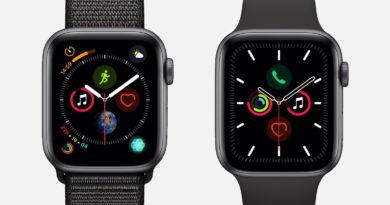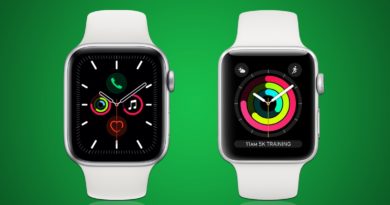Apple Watch battery life guide: 15 ways to keep the smartwatch powered for longer
![]()
Battery life on the Apple Watch may have improved down the years, but the smartwatch still requires almost nightly charging – no matter if you’re wearing a shiny new Series 4 or a Series 1, Series 2 or Series 3.
And though software updates continue to improve the Apple Watch’s battery efficiency, helping you eke out a bit more tracking before placing it on the charger, there’s plenty of things you can do to help keep things powered for longer.
More reading: Apple Watch tips for beginnersUntil the Apple Watch Series 5 lands – which we expect to stay powered for 2-3 days – here’s the best ways to improve battery life on the Apple Watch. And if you’re wondering how to check battery life on Apple Watch, or how many hours it should last, we’ve got you covered.How long does Apple Watch battery last?The most important thing to know about battery life is that it’s all relative; you could log a workout that drains the battery in a flash, or you could wear the watch all day without really checking it, helping it last longer. There’s tons of variables involved, and it’s up to you how much you’re able to stretch it out, as we’ll explore through the battery saving tips further below in this guide.
With that said, Apple does provide a general recommendation that applies to both the Series 4 and Series 3: 18 hours of battery life after an overnight charge.
Read this: How to charge the Apple WatchThat particular estimation factors in 90 time checks, 90 notifications, 45 minutes of app use and a 60-minute workout with music playback from Apple Watch over Bluetooth. In flatter terms, you could also zap the entire battery with a two-hour Bluetooth connected call, a one-hour LTE call or seven hours of streaming a playlist over LTE.
From our testing of all the Apple Watch generations, the equation has stayed much the same – this is a smartwatch that you’ll have to charge at some point every day. Whether that’s next to your phone at night, or on your desk after a daily workout, is entirely up to you. And that’s why it’s important to know how long the recharging process takes.
How long does it take to charge Apple Watch?For both the Series 3 and Series 4, Apple estimates that it takes 90 minutes to reach 80% battery, with 100% being reached after two hours on the magnetic charging cable. This may vary if you’re using a third-party charger.
Checking battery life on Apple WatchIf you’re new to the Apple Watch, you’d be forgiven for not stumbling across the battery percentage during your initial play-around in the menus. Here’s all the ways you can view how much juice you have left:
Swipe up on the watch face to access the Control Center and see the battery percentage. To tap into the Apple Watch’s low power mode, touch the battery percentage and then drag the Power Reserve tab.On some watch faces, you can add a battery complication. On an iPhone, you can add a battery widget to show the battery percentage of a connected Apple Watch. When your Apple Watch is charging in Nightstand Mode, simply hit the green charging icon to check the battery percentage. Apple Watch battery life tips1. Disable Wake on Wrist RaiseThe Apple Watch uses its gyroscope and accelerometer to instantly turn on the display for easy viewing whenever you raise your wrist. Unfortunately, this means that any time you raise your wrist the display will activate. Like when you’re watching a movie, or raising your hand, or stretching. And each time it does, battery life inevitably takes a tiny punch.
You can put an end to this by heading to Settings > General > Wake Screen and toggling off ‘Wake Screen on Wrist Raise’. You’ll then need to tap the screen or a button each time you want to wake the display.
2. Turn down the colorThere’s a reason the Apple Watch interface uses a black background: it’s more energy efficient for the device’s AMOLED display. Some of the watch faces, though, like Mickey Mouse or the Activity Face, use plenty of vibrant colors and, subsequently, more battery life.
Because watchOS lets you create a handful of customized watch faces you can easily slide between, you should set up a simple black-and-gray watch face to switch over to when you’re in a battery bind. There are a couple of minimalist faces, like Numerals and X-Large, that are perfect for this. Alternatively, if you’re really in a spot, you can turn on Grayscale mode by heading to General > Accessibility.
3. Reduce that motionThere are plenty of fancy graphical tricks in watchOS that are designed to make transitions as seamless as possible, but they also draw a little more power from the processor, which in turn draws a little more life out of that battery. If you don’t need the neat melding animation to the app home screen or transparency effects when you swipe down on the notification pane, you can turn them both off in the Accessibility menu in the Watch app.
4. Unlock with iPhoneWhen you’re setting up your Apple Watch, it’ll ask you whether you’d like to turn on Unlock with iPhone. It works exactly like it sounds; when you unlock your iPhone, it’ll also unlock your Apple Watch. You won’t have to type in your passcode on that tiny Watch screen, which is a wonderful convenience, but you’ll also save time not inputting a passcode, saving precious seconds of display time and, by extension, saving some battery life.
5. Turn off the heart rate monitorIf you’re not interested in the Apple Watch tracking your heart rate every couple of minutes, you can disable the heart rate monitor. While the heart rate monitor constantly checking your pulse improves the accuracy of calorie estimations, it does take up a significant chunk of battery power to do so.You can turn it off by heading to the Watch app on your iPhone and going to Privacy > Motion & Fitness. While you’re there, you can also turn off fitness tracking if the fitness elements of the watch aren’t vital to you.6. Customize iPhone mirroringMirroring core iPhone apps like Mail, Messages and Calendar can be extremely helpful, but they can also be redundant. Do you really need both your Watch and iPhone to ring when someone calls you? Even worse, it sucks battery life. Especially something like Mail, which’ll keep pinging your iPhone for new emails.
Read this: The best Apple Watch strapsYou can reduce these issues by customizing how the Watch mirrors those core iPhone apps in the My Watch pane of the Watch app. You can turn off Phone alerts, disable Message alerts and choose which of your mailboxes can send you Watch alerts.
7. Workout Power Saving ModeIf you want to save battery life while working out, Apple has a mode for you. If you turn on Workout Power Saving Mode in the General section of the Watch app, the phone will turn off the heart rate monitor for walking and running exercises. Your calorie burn calculations may be less accurate, but you’ll gain some battery life during workouts. 8. Get rid of Activity RemindersThe Activity app is always on your case. If you’ve been sitting for 50 minutes in an hour it’ll remind you to stand. It’ll give you progress updates every four hours. It’ll notify you when you get an achievement. And then, every week, it’ll send you a summary of what you did and recommend new goals for the next week. It’s helpful stuff, but all those notifications can ding battery life significantly. You can turn them off in the Activity menu of the companion app.
9. Adjust the haptic vibrationsSure, getting that gentle buzz when you receive a text, prompt or call is a great way to keep up to date in a discreet way, but limiting this can also have a slight effect on your battery.
If you head to to Settings and go into Sounds & Haptics, simply turn off Prominent Haptics off. Or, alternatively, you can also fiddle with the haptic strength by sliding the control.
10. Turn off SiriEvery time your display is on, your Apple Watch is searching for those two magical words, “Hey Siri,” so that Apple’s personal assistant can set your next appointment or play your favorite song. It’s a good way to accomplish things hands free, but it’s also a good way to drain your battery. You can turn it off by going to the Siri menu of the General section in the Settings app on your Apple Watch.
11. Turn on Do Not DisturbYou’re in a big meeting and want to neutralise your Apple Watch pings, but you also want them to return after the meeting without having to faff about in big menus. Sounds like you need a healthy dose of Do Not Disturb, friend.
To access Do Not Disturb, simply swipe down from the watch face and bring up the Control Center. Hit the moon icon, as shown above, and your Watch will avoid lighting up, buzzing or making noise for a temporary period. To adjust just how long this period is, Force Touch the icon. Handily, like on the iPhone, Do Not Disturb can be set to end when you leave your current location, when an event in your Calendar ends or simply for a select period of time.
12. Slim down background refreshesAll of those apps on your Apple Watch are constantly refreshing in the background, pulling in new information so that when you open up the app, you have the latest news or sports score right there with minimal waiting. That convenience comes at a price: battery life.
There’s a Background App Refresh menu in the General section of the Watch app. That’s where you’ll be able to either turn off all background refreshes or toggle them on or off for individual apps. So you can prioritize refreshes in apps you rely on while turning them off on non-essential apps you rarely use, saving battery life.
13. Turn off the soundThe Apple Watch can ring whenever you receive a notification, which can be helpful if you’re not into haptic feedback, but isn’t so helpful with battery life. You can turn off the sound pretty quickly by swiping up, tapping the bell icon and being done with the beeps and bops.
14. Use Theater ModeTheater Mode is great for meetings and dark places – like a movie theater, duh – where you expect notifications, but you don’t want your screen accidentally turning on and distracting everyone else.
Bonus benefit: Because it doesn’t turn on the screen, it’s not using as much battery power, which means you’ve got a little more juice to get you through the day.
15. Turn on Power Reserve modeIf you’ve done everything you can, and you’re still in danger of running out of juice, there’s always Power Reserve mode to tap into. You can turn this on by pressing and holding the power button and then choosing Power Reserve. This’ll shut down all features except the time, meaning you won’t be stuck with a dead screen on your wrist.


